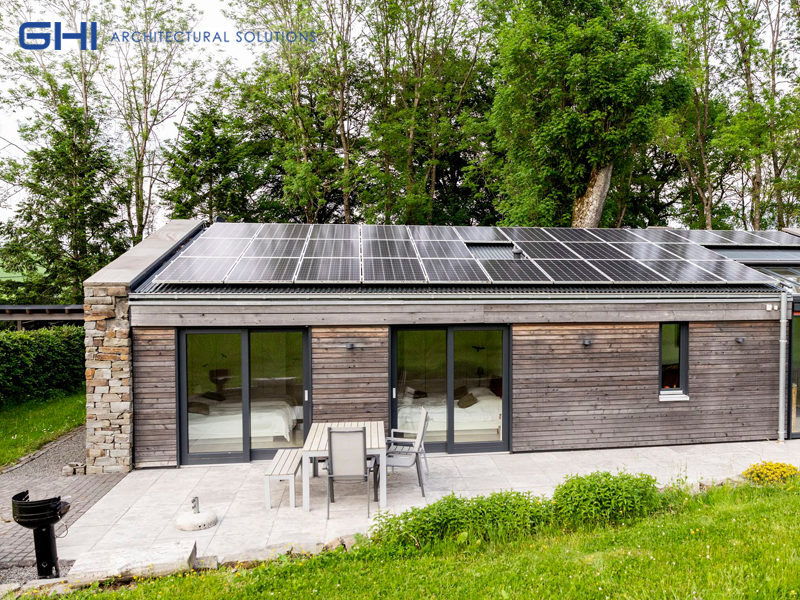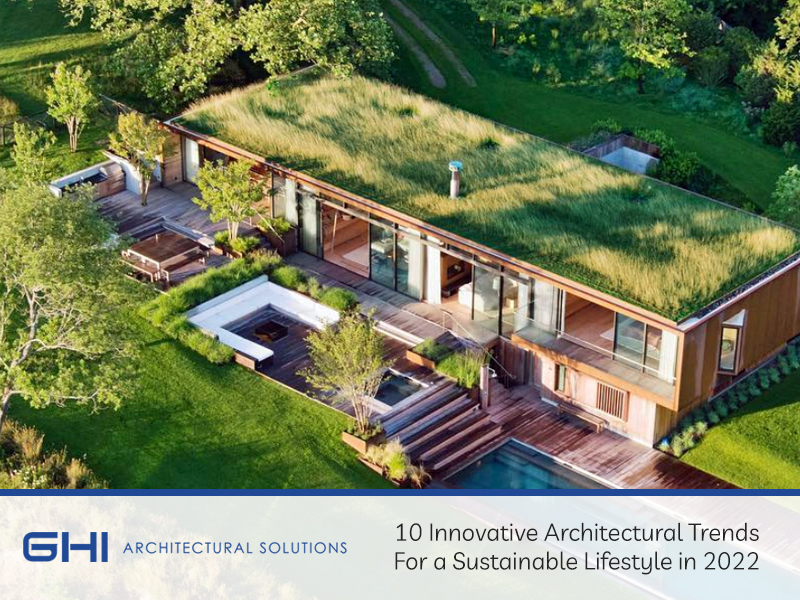10 Innovative Architectural Trends For a Sustainable Lifestyle in 2022
Architects are constantly striving to update building designs to meet the demand for a more sustainable lifestyle while still adding functionality and comfort. Architectural trends continue to evolve and it’s no different in 2022 with the focus being on minimalism, sustainability and the use of eco-friendly materials.

1. Sustainable Architecture – Natural Living
Eco-conscious homeowners are always looking for ways to build eco-friendly homes that work with nature – not against her! Sustainable architecture involves integrating the infrastructure with the natural environment while being mindful of resources at the same time. It allows you to live a cleaner, minimalist lifestyle while reducing your carbon footprint.
Architects are mindful of the heat island effect in urban developments and counteract this by bringing greenery closer to the home, reducing the need for costly air conditioning units. Eco-friendly features such as solar panels, rainwater harvesting tanks and biodigesters become part of the sustainable home’s structure, encouraging off-the-grid living.
2. Tiny Homes Architecture – Compact Living
With the cost of living escalating daily, homeowners are seeking out cost-effective home designs while downscaling. Tiny homes have been trending for some time now and compact living isn’t only environmentally-friendly but it’s also economical.
Constructed with second hand shipping containers or reclaimed building materials such as timber, steel or cleaned bricks, tiny houses are normally no bigger than 400 square feet in floor area. These micro-dwellings include eco-friendly architectural features such as large windows for bringing in as much natural lighting as possible, reducing the need for artificial lighting.
3. Solar Energy Architecture
Increased awareness around the impact of burning fossil fuels to power homes and businesses is forcing people to reassess how they source energy. This includes architects who are integrating solar power features into their building designs to meet the demand for a greener lifestyle.
Solar energy can be used to power up whole homes, office buildings and manufacturing plants. It’s a cleaner and sustainable alternative to relying on coal-powered national grids. Architects are finding attractive but functional ways of incorporating solar panels into their designs. These include:
- Using them as shading material on external structures such as patios
- Disguising them by incorporating them into the rooftop
- Using the “form follows function” which means placing the house strategically to get the most benefit from the sunlight while allowing for easier and more effective solar panel installation.
Solar architecture is a growing trend with many new housing developments incorporating panels from the beginning to encourage off-the-grid living.
4. Scandinavian Architecture – The Nordic Design
Scandinavian building design focuses on merging with the natural surroundings, using materials such as wood and glass, for clean aesthetics. Its key focus is simplicity and minimalism. A lot of attention is placed on the building process, ensuring it’s sustainable.
Scandinavian homes incorporate large glass windows, often reaching from the floor to the ceiling for abundant interior natural lighting. Open floor plans help to create a decluttered look while wood combined with a lightweight metal such as aluminum is often used to create clean lines.
Scandinavian architecture isn’t new having first surfaced in the early 20th century. But architects are incorporating fresh, sustainable ideas to support the use of this building design for the eco-conscious property owner.
5. Prefabricated Architecture – Going Modular
If you’re looking for simplicity, reduced living costs and sustainability when building a new home, quickly and efficiently, consider a prefabricated building. No longer plain and dull, your prefabricated home can look modern and stylish while still being environmentally friendly. Building your modular home from scratch has many benefits including:
- Reduced emissions and waste with less time used to build a structure offsite
- Off-the-grid features such as solar panels
- Water savings with the installation of rainwater harvesting systems
Prefabricated architects are evolving the way these modular homes look and function. What’s more, they’re using prefabricated wood to construct office buildings, potentially creating a wave for the future, not only for 2022!
6. 3D Printed Architecture – Architectural Visualisation
Keeping up with the latest technology is essential in the architectural industry if designers want to stay ahead of the pack! Using 3D printing as a way of visualising a structural design is a popular method used by many up-and-coming architects. It reduces human error while enhancing two-dimensional and three-dimensional creations for improved visualisation of an architectural design.
Using this technology allows architects to stimulate eco-friendly effects such as ventilation and lighting inside the building. Using 3D architectural visualisation is powerful for meeting the needs of a client seeking a greener, mindful lifestyle while making it easier to “see” the proposed outcome of a design.
7. Minimalist Architecture – A Minimal Lifestyle
Minimalist architecture is a response to the call for a clean, clutter-free and calmer living space. The key characteristics of this trending architectural design are:
- Reduced visual clutter with less ornamentation on the building.
- Minimal structural design using geometric shapes, simple angles and clean lines.
- Large expanses of glass to maximise the use of natural lighting.
- Building materials such as aluminum, steel, stone and glass while retaining neutral colours.
Mastering this type of architecture requires paying attention to the smallest design feature while still producing a functional and comfortable home.
8. Floating Architecture – Living on Water
Floating architecture continues to trend as people look for ways to shift their businesses and homes from land to water. Architects strive to meet this increasing demand by using innovative and creative ideas to float structures on water bodies. Floating buildings include hotels, shopping malls, cinemas, housing and office buildings.
Keeping sustainability at the forefront of their designs, floating architectural designers have adopted the use of solar panels and locally sourced or biodegradable building materials. This is becoming more evident in floating homes being built worldwide, using photovoltaic panels, stainless-steel beams and wood paneling.
9. Cabin Architecture – Simple Rural Living
Cabin architecture and design is another trend that simply won’t go away! Continuing to meet the demand of those moving out of the city, seeking a calmer lifestyle in nature, cabin-living appeals to many. From modest to more elaborate designs, cabin architecture has also responded to the call for more environmentally-friendly features.
Keeping up with the latest architectural design trends, cabin designs are incorporating the following:
- Off-the-grid features such as solar panels and wind turbines.
- Durable aluminum cladding both inside and outside.
- Eco-friendly cross-laminated timber for structural strength and simplicity while reducing on-site waste consumption.
Using locally-sourced building materials also decreases carbon footprint during construction.
10. DIY Architecture – For the Amateur Builder
If you’re a builder at heart but have no clue how to build your own home, relax! Ordering a DIY structure that comes with a complete kit and instructions allows you to fulfill your dream of building your own home. These flat-packed architectural designs include a step-by-step process that any amateur builder can follow without needing the services of a professional.
DIY architecture gives you the freedom of using sustainable practices while building your dream home. These kits also reduce the number of building materials you need, decreasing construction wastage and overconsumption of natural resources. You also get to choose whether to live off-the-grid or not when building your own home.
Final Thoughts
Building on current industry ideas, architects are using creativity and innovation to align their structural designs with the need for a more mindful way of living and working. While some of the latest architectural trends may seem simple, there is nothing boring about them! And, some of them are here to stay well beyond 2022!

